
© Stephanie Berger. (Click image for larger version)
Dorrance Dance
Jungle Blues, Three to One, Basses Loaded, Lessons in Tradition, Harlequin and Pantalone, Jump Monk
★★★✰✰
New York, City Center
30 March 2019
www.dorrancedance.com
www.nycitycenter.org
Crossroads
Michelle Dorrance is at a crossroads. This brilliant tap innovator and creative mind is rightly celebrated for her inclusive, inventive, and ever-curious approach to tap. She is a darling of festivals, presenters and audiences, and has recently crossed over into the realm of ballet. But how much crossover and reinvention is too much? Her company’s current run at New York City Center suggests that she might benefit from a little bit more time – time to develop her ideas into something more substantial and fine-tuned, like her wonderful 2013 work The Blues Project. Blues Project had everything: virtuosity, a sense of theatre and history, complexity, and, importantly, momentum. It felt complete. In contrast, the current program, which also includes works by other choreographers, comes across as a collection of intriguing but unfinished etudes.
We get a sense of Dorrance’s probing curiosity, of her hunger to test the edges of tap, as well as her desire to celebrate rather than stifle the individuality of her dancers. They vary enormously in style, sound, body type, and talent. Some are ingratiating, others are brassy or introspective. One, Warren Craft, wears a quizzical expression and moves his sinuous arms like a magician weaving a spell. Nicholas Van Young is like a bear with fast-moving, piston-like legs. Elizabeth Burke moves as if in a dream. It’s a company of soloists and improvisers – tap is an improvisational form – but at times the variety gets in the way, leaving an impression of raggedness and clashing energies.
This impression is augmented by the lack of development in the works themselves. Jungle Blues, an ensemble set to a recording by Jelly Roll Morton, is the least realized. The ensemble provides a backdrop to a series of solos and duets, the most effective of which is a passage for Christopher Broughton full of slides, perilous balances, tilts and wild leg swings. The rest feels like filler. Three to One, a trio for Dorrance, Byron Title, and Matthew “Megawatt” West, is an experiment in quietness set to clock-like music by Richard D. James, in which Dorrance creates flurries of delicate footwork. The two men are barefoot; Dorrance is in tap shoes. Knees turn inward and outward. (The lighting, by Kathy Kaufmann, focuses on the patterns created by the dancers’ legs and feet.) The trio is followed by a solo for Dorrance in which she glides across the stage in tiny steps, the tap equivalent of a balletic bourrée. An interesting idea, as far as it goes.
In Basses Loaded, Dorrance trades her tap shoes for an electric bass, which she plays alongside her bass-playing brother, Donovan. They are joined by Kate Davis and Gregory Richardson, on double bass. Later in the evening, Davis sings and plays the ukulele. This flexibility and multi-tasking is one of the show’s most appealing elements, as is Dorrance’s apparent delight in every role she plays: musician, ensemble dancer, soloist, partner. She’s an enthusiast, and that enthusiasm is infectious. The dancers here are Elizabeth Burke, Warren Craft, Byron Tittle, and Luke Hickey – the latter a polished, Broadway-style hoofer. The four dancers create a series of moving formations, gliding around the stage. Eventually, the musicians join them, weaving through, dancing with their instruments. It’s an amiable piece, but too long and, ultimately, formless.
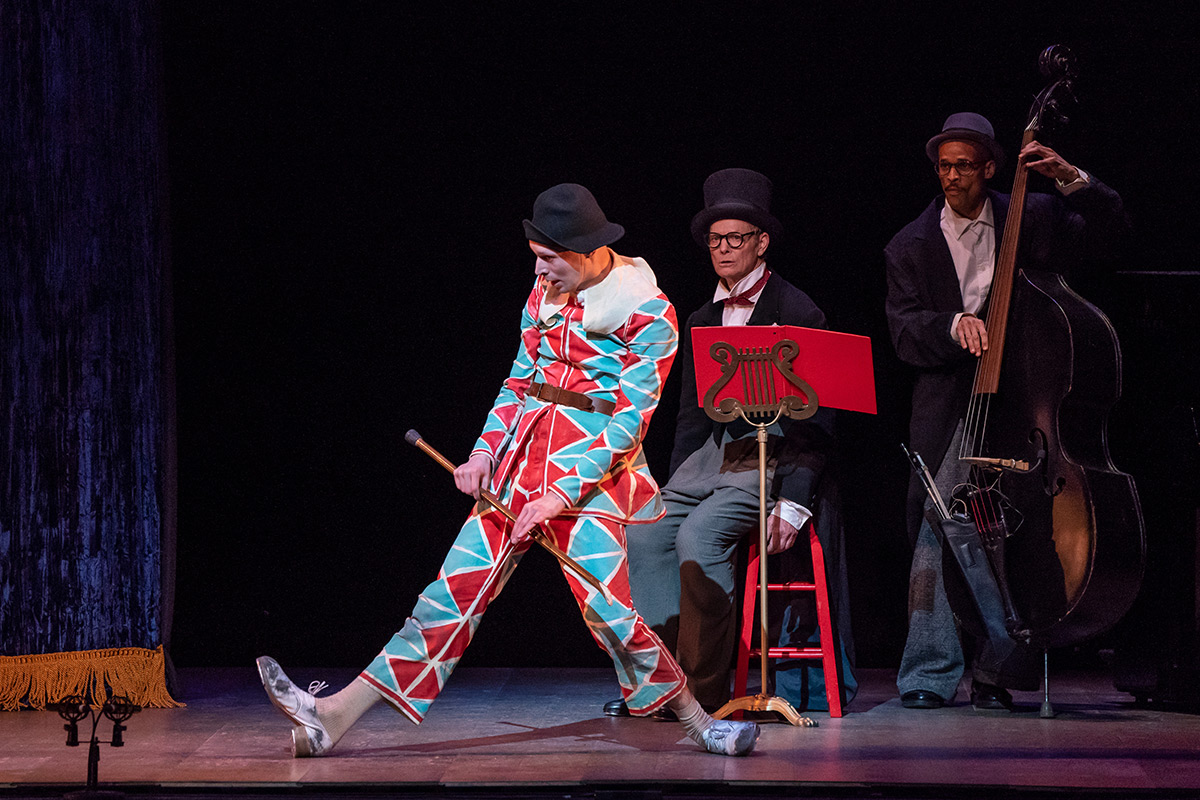
© Stephanie Berger. (Click image for larger version)
What a contrast with the second half of the program, dominated by the vaudevillian Bill Irwin and closing with a work by Brenda Bufalino. Bill Irwin’s two contributions, Lessons in Tradition and Harlequin and Pantalone, did much to shore up the evening. It was immediately evident that we were in the hands of an experienced theatrical mind – Irwin is an actor, director, writer, and clown. The two pieces, though slight, were a shining example of wit and comic timing. In Lessons in Tradition, a collaboration with Dorrance – created for the Vail Dance Festival – Irwin danced a soft shoe while making jokes about the excesses of the “new” style of tap. After which, he and Dorrance danced together, joined by the sweet-voiced, tongue-in-cheek Kate Davis. It’s a sliver of a piece, but filled with charm. Harlequin and Pantalone, choreographed and narrated by Irwin, is a commedia dell’arte skit in which the lanky, shape-shifting Warren Craft – he of the wayward arms – plays the role of both the servant Harlequin and his crotchety master Pantalone. Here, Craft’s unique, puppet-like physicality was put to brilliant use, as he collapsed like a broken doll and folded himself into a wooden trunk, or walked around in a crouch, his legs hidden by a tent-like blouse.
Bufalino’s Jump Monk closed the evening. Bufalino, like Dorrance, is an innovator who advanced the range and variety of tap through her American Tap Dance Orchestra in the 80’s and 90’s. In this large ensemble piece, created on students in 2011, she uses the dancers’ differences to great effect, creating a conversation between styles, while maintaining a strong rhythmic and structural base. Everyone has a moment to shine, but there is also a sense of the joyousness and power of the group. It may be old hat, but there are few things as exciting to the ear and eye as a large group of dancers tapping together.
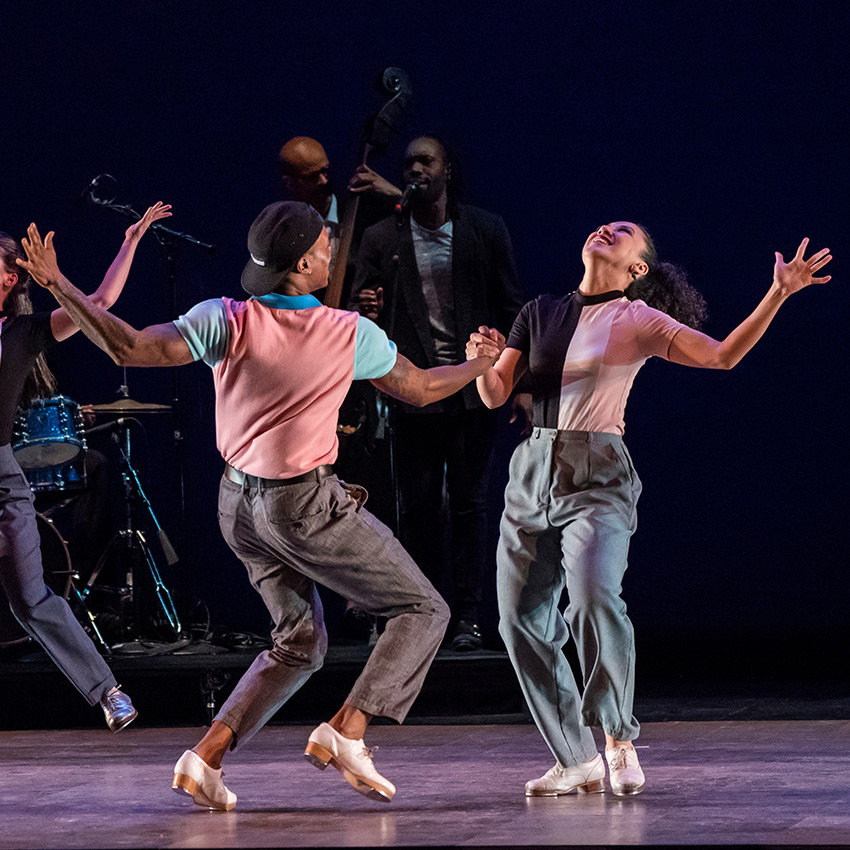
© Stephanie Berger. (Click image for larger version)
Bufalino finds just the right equilibrium of craft and freedom, of individuality and unison. It just goes to show, there is still a lot to be learned from the veterans.












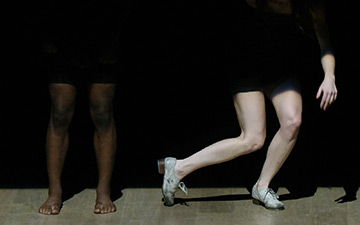

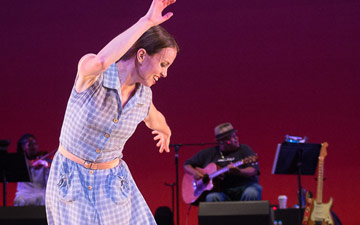
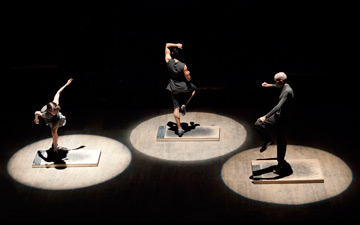
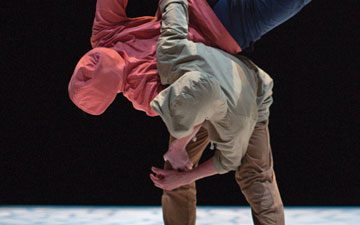
You must be logged in to post a comment.